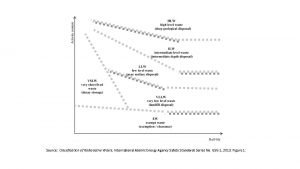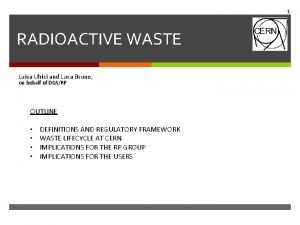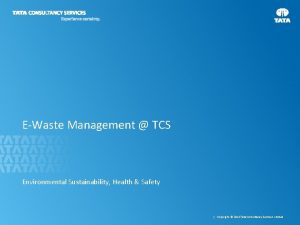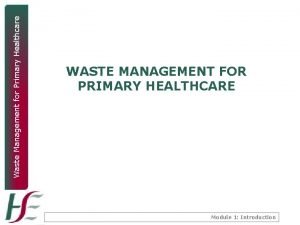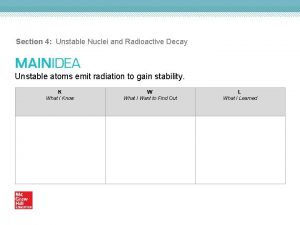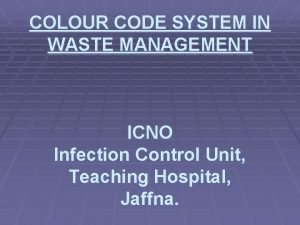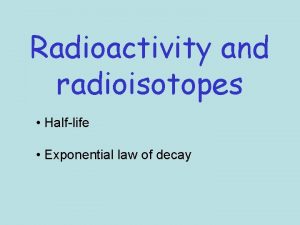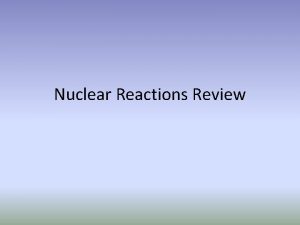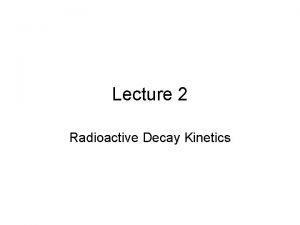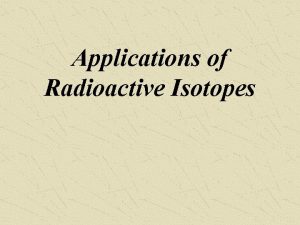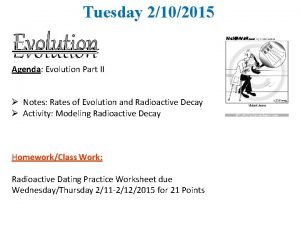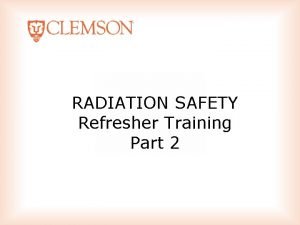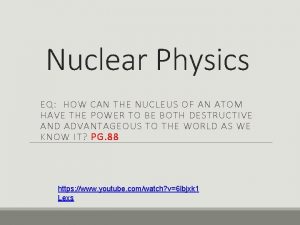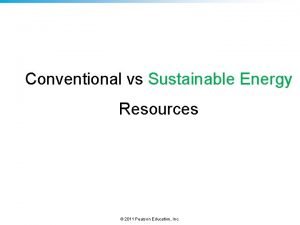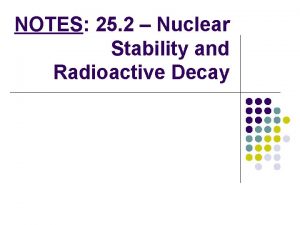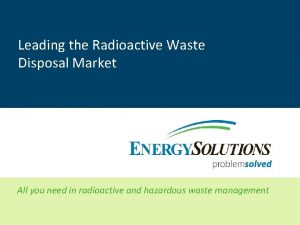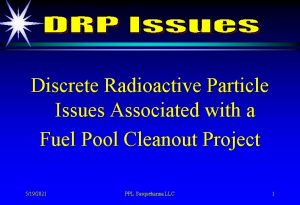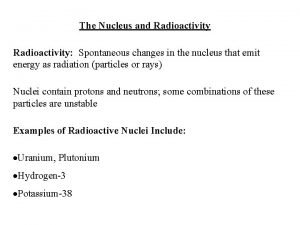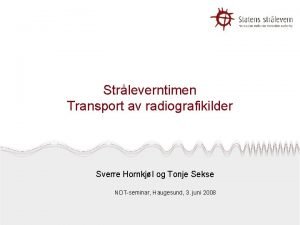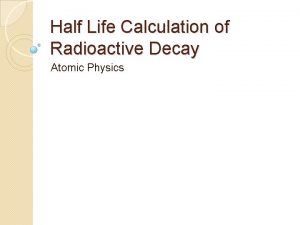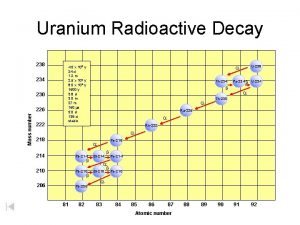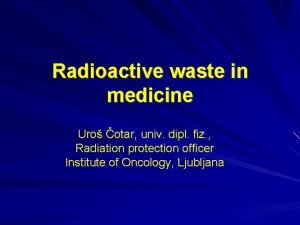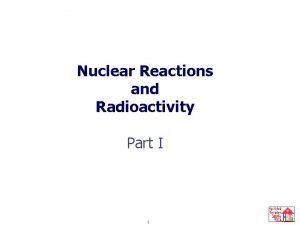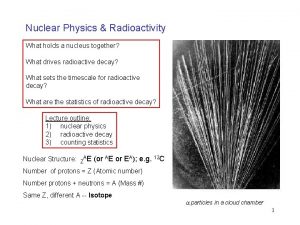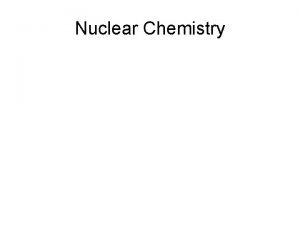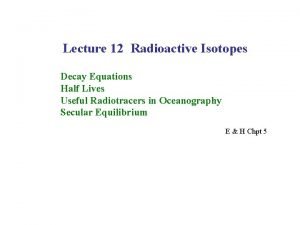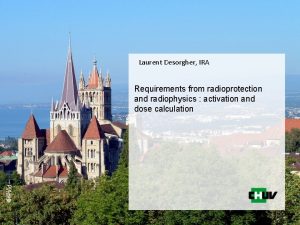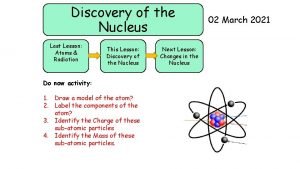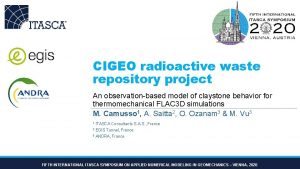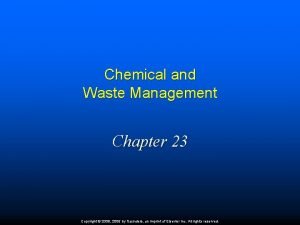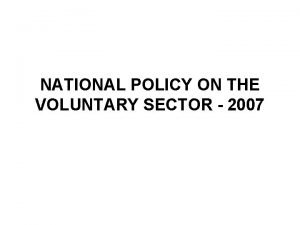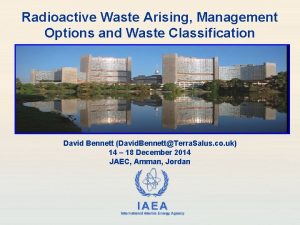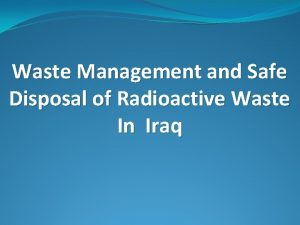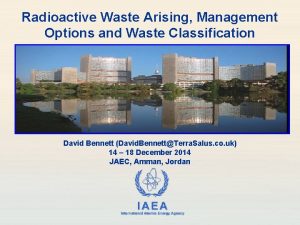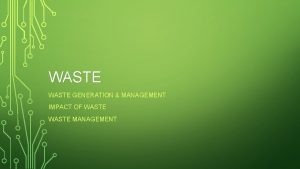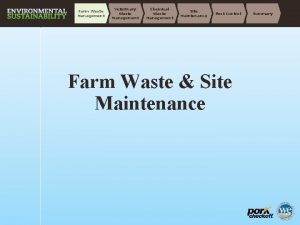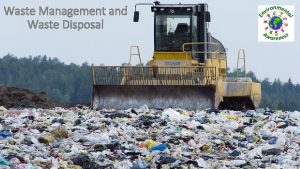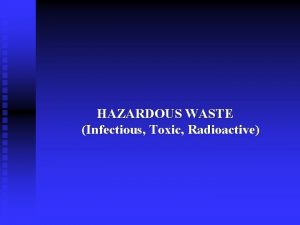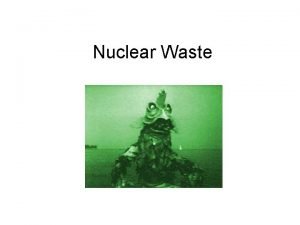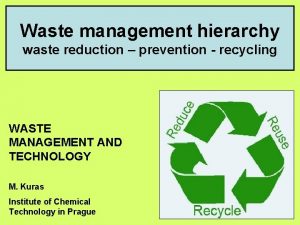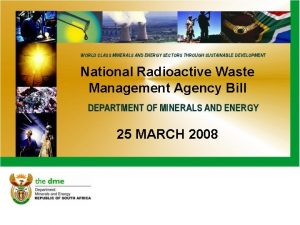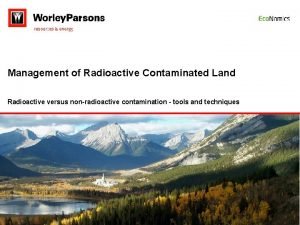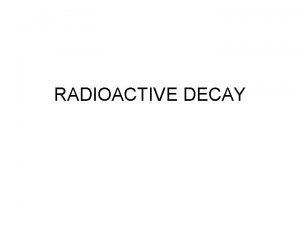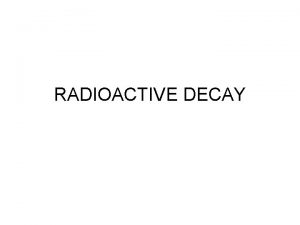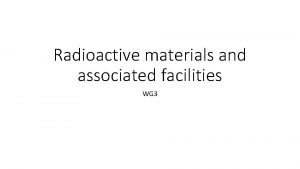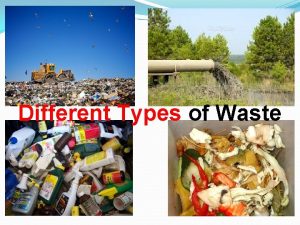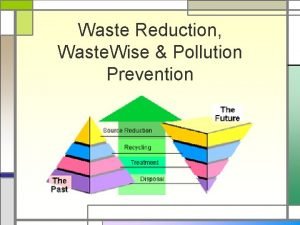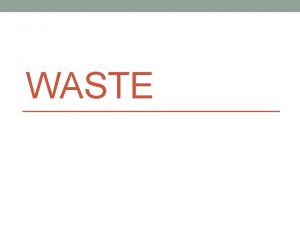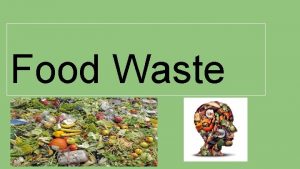National Policy and Strategies for Radioactive Waste Management









































- Slides: 41

National Policy and Strategies for Radioactive Waste Management David Bennett (David Bennett@Terra. Salus. co. uk) 14 – 18 December 2014 JAEC, Amman, Jordan IAEA International Atomic Energy Agency

Contents • National policy and strategy • Strategies for waste management • Examples IAEA 2

Background Every country should have some form of policy and strategy for managing its spent fuel and radioactive waste • Required/recommended in some IAEA publications and in the Joint Convention, but the contents of a national policy and strategy are not elaborated in these documents • In some Member States national policy and strategy are well established, in others they exist but without explicit statement; in many developing states they do not exist => A need to help in developing or upgrading national policies and strategies in a number of states IAEA 3

What is Policy and What is Strategy? Policy is about goals, aims and objectives – e. g. what Government wants to do • In its simplest form a radioactive waste management policy states that radioactive waste shall be managed in a safe way Strategy is about how to achieve policy goals, aims and objectives IAEA 4

IAEA Safety Requirements “Decommissioning of facilities and the safe management and disposal of radioactive waste shall constitute essential elements of the governmental policy and the corresponding strategy over the lifetime of facilities and the duration of activities” IAEA 5

IAEA Safety Requirements Requirement 2: National policy and strategy on radioactive waste management • To ensure the effective management and control of radioactive waste, the government shall ensure that a national policy and a strategy for radioactive waste management are established • The policy and strategy shall be appropriate for the nature and the amount of the radioactive waste in the State, shall indicate the regulatory control required and shall consider relevant societal factors IAEA 6

IAEA Document NW-G-1. 1 “Policies and strategies for spent fuel and radioactive waste management” IAEA 7

NW-G-1. 1 Objectives • To set out the main elements of national radioactive waste management policy and strategy • To advise on procedures for development and implementation • To advise on policy–strategy links • To serve as an aid, resource and reference for those engaged in its development or updating of policy and strategy IAEA 8

Policy and Strategy • Policy • • Determined by government Often codified in the national legislative system Provides principles, infrastructures Provides formal requirements for implementation and for the development of appropriate strategies • Strategy • Normally established by the relevant waste owner or facility operator • National policy may be elaborated in several different strategies • The individual strategies may address different types of waste (e. g. reactor waste, decommissioning waste, institutional waste, etc. ) or waste belonging to different owners. • The line separating policy from strategy is not always sharp => sometimes mixtures exist IAEA 9

Policy – Strategy Links GOVERNMENT PARLIAMENT FORMULATE POLICY STATEMENT INTERNATIONAL OBLIGATIONS (TREATIES, AGREEMENTS, CONVENTIONS) NATIONAL CIRCUMSTANCES (ENERGY POLICY, RESOURCES, RW INVENTORY) NATIONAL LEGISLATIVE SYSTEM MINISTRIES REGULATORS IMPLEMENT POLICY NATIONAL RWM INFRASTRUCTURE FUNDING SYSTEM RWM AGENCY and GENERATORS IAEA ELABORATE STRATEGY TECH. INFRASTRUCTURE, RESOURCES, TIME CONSTRAINTS IMPLEMENT STRATEGY TECHNICAL OPTIONS 10

Why do we need a Policy? • To define what is to be done (e. g. nuclear power production, waste • • • storage, reprocessing, waste disposal) To allow and enhance public discussion and confidence in RWM As a basis for the preparation of related legislation To define roles and responsibilities in radioactive waste management (RWM) To provide for safety and security To ensure the adequate allocation of financial and human resources As a starting point for the development of strategies IAEA 11

National Policy • ‘What state wants to do to ensure safe management of waste’ • Reflects national priorities, circumstances, structures, human and financial resources • Policy > Strategy +/- Legislation • Should be updated from time to time IAEA 12

National Policy • Should be compatible with: • Joint Convention on the Safety of Spent Fuel and Radioactive Waste Management • IAEA safety documents • EC Directives and other International Agreements (where applicable) • Should be based on knowledge of: • Existing wastes • Likely future waste generation • Should provide for independent regulatory oversight and public/stakeholder involvement IAEA 13

Information for Policy Development Knowledge of: • • Legal framework Institutional structures Applicable international conventions and agreements Other related and existing national policies and strategies Spent fuel and radioactive waste inventory Availability of resources Situation in other countries Stakeholder involvement IAEA 14

Example Policy Elements • Description of national priorities, circumstances, relevant organisational structures and infrastructure, human and financial resources • Policy on nuclear power and NPP development / decommissioning • Policy on NPP fuel management • e. g. direct disposal or reprocessing • Policy on import and export of radioactive materials and wastes • Policy on management of radioactive wastes • waste classification • options for disposing different types of wastes IAEA 15

Example Policy Elements (cont. ) • Allocation of responsibilities to organisations • e. g. operators, regulators • Principles: • e. g: the polluter pays principle, waste minimization, public participation • Safety and security objectives • Arrangements for the provision of financial resources • e. g. , segregated funds IAEA 16

Implementation of a National Policy • Establish an adequate and appropriate institutional framework (operators, regulators etc. ) • Create a funding mechanism to provide adequate financial resources for the whole RWM lifecycle (to finance the necessary facilities, equipment and staff for RWM) • Ensure that the staff involved are sufficient, trained and competent IAEA 17

Why do we need a Strategy? • To specify how the national policy will be implemented by the responsible organizations using the available technical measures and financial resources • To define how the identified goals and requirements will be achieved and when • To identify the competencies needed for achieving the goals and how they will be provided • To elaborate how to manage the various waste types • To involve the public and build their confidence in the approach to safe and secure management of radioactive wastes IAEA

Information for Strategy Development • Knowledge of: • • • National policy on nuclear energy and waste management Inventory of spent fuel and radioactive wastes Waste stream characterization Waste classification system Existing waste management facilities Future plans – new NPPs, mineral processing, etc Stakeholder expectations and interests Existing regulatory regime Availability of resources Waste management strategies in other countries IAEA 19

Considerations in Strategy Development • • Compliance with policy Inventory of waste types Graded approach Resources (financial, human, technical) Technical options (shared, centralised, mobile facilities) Country specifics (population, climate, neighbours) Public sensitivity Uncertainties IAEA 20

Strategy Formulation/Implementation Assign responsibility for strategy development Assess adequacy of available information Define possible endpoints Identify possible technical options Determine optimal strategy Assign responsibilities for implementation Inadequate inputs Establish supervisory mechanism for implementation Develop strategy implementation plan Implement strategy IAEA 21

Strategies for Waste Management It is simple to describe. . . • Assess the present situation • Consider waste management from generation to • • • disposal Identify problems / needs for development Identify and select options Devise a plan Secure funding Execute the plan IAEA 22

Strategies for Waste Management But in practice… • • • Need funding Political system involved Public trust needed on key components IAEA 23

Strategies for Waste Management Prerequisites: • Operational capability to deal with waste • Operators and facilities • Independent regulatory capability • Legal framework and regulatory body IAEA 24

Strategies for Waste Management System of waste management: • • Sum of required individual components May involve many organisations Effective use of resources to get the best result Different from country to country IAEA 25

Strategies for Waste Management Establishing a waste management system requires: • Identification of the parties involved in the different steps • Control / minimisation of radioactive waste generation • Identification of existing and anticipated radioactive wastes • A rational set of safety, radiological and environmental protection objectives IAEA 26

Strategies for Waste Management Establishing a waste management system requires: • Identification of available methods and facilities • Consideration of interdependencies among all steps of waste generation and management • Appropriate research and development • Funding and the allocation of resources for radioactive waste management IAEA 27

Strategies for Waste Management: Important components • • Independent regulatory oversight Licensing/registration process Waste inventory Management system Safety culture Safety cases and assessments Defined planning and decisionmaking processes • Research and development • Documentation and records • Staff training and qualification • Emergency planning IAEA • Institutional control 28

Strategies for Waste Management Example disposal strategies • • • Spent fuel wastes and HLW - geological disposal DSRS - decay or geological disposal or borehole? LILW (long-lived) - geological disposal LILW (short-lived) - engineered shallow disposal VLLW - landfill? Mining and milling wastes – surface management? • [human intrusion, long-term radon doses] IAEA 29

Strategies for Waste Management Disposal strategies - realities • What to do with historical wastes? • What to do with small amounts of wastes? • What to do when disposal is not yet possible • Storage facilities • What to do when there are not enough resources? IAEA 30

Waste Management Strategy – Generic Example IAEA Decommissioning of Small Medical, Industrial and Research Facilities, IAEA 31 TECDOC-1041, 1998

Updating Policy and Strategy • Experienced obtained • New national circumstances • New international agreements • Policy updating (government) • Strategy updating (operator) IAEA 32

National Policy/Strategy Example: Finland: • 4 reactors (1 under construction) • 1 research reactor • Industrial and medical and research use of radiation • ~1, 400 tonnes U as spent fuel • ~6, 500 m³ L/ILW • <100 m³ ‘small users’ wastes IAEA 33

National Policy/Strategy Example: Finland Government Policy of 1983 Operational wastes: • Plans for construction of LILW disposal facilities by the end 1986 and - if needed - commissioning by 1992 Decommissioning: • Updated plans for decommissioning of NPPs at 5 year intervals Spent fuel disposal, milestones: • Site screening and selection of several sites by the end of 1985 • Prelim. site investigations and selection of most suitable sites 1992 • Detailed site investigation and site selection by the end of 2000 • Application for construction of the encapsulation and disposal facility by the end of 2010 • Planning for operation of the facilities around ~2020 IAEA 34

National Policy/Strategy Example: Finland IAEA 35

Example Strategy of a Waste Producer IAEA 36

Example policy of a small-scale waste producer (1 of 4) IAEA 37

Example policy of a small-scale waste producer (2 of 4) IAEA 38

Example policy of a small-scale waste producer (3 of 4) IAEA 39

Example policy of a small-scale waste producer (4 of 4) IAEA 40

IAEA Thank you! 41
 Radioactive pollution conclusion
Radioactive pollution conclusion Radioactive nuclear waste
Radioactive nuclear waste Radioactive waste
Radioactive waste E-waste management policy-tcs
E-waste management policy-tcs Policy on waste segregation
Policy on waste segregation How unstable atoms gain stability
How unstable atoms gain stability National child policy 1974
National child policy 1974 Icno
Icno Exponential law
Exponential law Most unstable radioactive element
Most unstable radioactive element Radioactive materials have unstable
Radioactive materials have unstable Calculation of radioactive decay
Calculation of radioactive decay Chapter 24 nuclear chemistry answer key
Chapter 24 nuclear chemistry answer key Applications of radioisotopes
Applications of radioisotopes Law of radioactive decay
Law of radioactive decay Radioactive tracers in agriculture
Radioactive tracers in agriculture Radioactive dating worksheet
Radioactive dating worksheet Radioactive defination
Radioactive defination Refresher training example
Refresher training example Beta minus decay
Beta minus decay Radioactive fallout from chernobyl
Radioactive fallout from chernobyl Radioactive rays
Radioactive rays Radioactive decay
Radioactive decay Radioactive materials logistics market
Radioactive materials logistics market Discrete radioactive particles
Discrete radioactive particles Radioactive examples
Radioactive examples Un3332 radioactive material
Un3332 radioactive material How to calculate half life physics
How to calculate half life physics Is lead radioactive
Is lead radioactive Rolf sievert
Rolf sievert Balancing nuclear reactions
Balancing nuclear reactions Radioactive decay law
Radioactive decay law Chemistry
Chemistry Radioactive decay formula
Radioactive decay formula Radioactive decay formula
Radioactive decay formula Type of radioactive decay
Type of radioactive decay Plum pudding vs nuclear model
Plum pudding vs nuclear model Radioactive flac
Radioactive flac Chemical and waste management chapter 23
Chemical and waste management chapter 23 Objective of zoo
Objective of zoo Existanxe
Existanxe National policy on the voluntary sector 2007
National policy on the voluntary sector 2007

